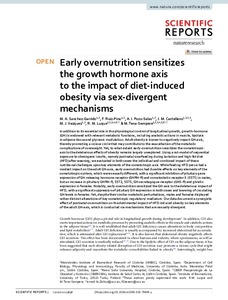Early overnutrition sensitizes the growth hormone axis to the impact of diet-induced obesity via sex-divergent mechanisms
R. M. Luque; M. Tena-Sempere; A. I. Pozo-Salas; F. Ruiz-Pino; M. A. Sanchez-Garrido; J. M. Castellano; M. J. Vazquez
Early overnutrition sensitizes the growth hormone axis to the impact of diet-induced obesity via sex-divergent mechanisms
R. M. Luque
M. Tena-Sempere
A. I. Pozo-Salas
F. Ruiz-Pino
M. A. Sanchez-Garrido
J. M. Castellano
M. J. Vazquez
NATURE PUBLISHING GROUP
Julkaisun pysyvä osoite on:
https://urn.fi/URN:NBN:fi-fe2021042823042
https://urn.fi/URN:NBN:fi-fe2021042823042
Tiivistelmä
In addition to its essential role in the physiological control of longitudinal growth, growth-hormone (GH) is endowed with relevant metabolic functions, including anabolic actions in muscle, lipolysis in adipose-tissue and glycemic modulation. Adult obesity is known to negatively impact GH-axis, thereby promoting a vicious circle that may contribute to the exacerbation of the metabolic complications of overweight. Yet, to what extent early-overnutrition sensitizes the somatotropic-axis to the deleterious effects of obesity remains largely unexplored. Using a rat-model of sequential exposure to obesogenic insults, namely postnatal-overfeeding during lactation and high-fat diet (HFD) after weaning, we evaluated in both sexes the individual and combined impact of these nutritional challenges upon key elements of the somatotropic-axis. While feeding HFD per se had a modest impact on the adult GH-axis, early overnutrition had durable effects on key elements of the somatotropic-system, which were sexually different, with a significant inhibition of pituitary gene expression of GH-releasing hormone-receptor (GHRH-R) and somatostatin receptor-5 (SST5) in males, but an increase in pituitary GHRH-R, SST2, SST5, GH secretagogue-receptor (GHS-R) and ghrelin expression in females. Notably, early-overnutrition sensitized the GH-axis to the deleterious impact of HFD, with a significant suppression of pituitary GH expression in both sexes and lowering of circulating GH levels in females. Yet, despite their similar metabolic perturbations, males and females displayed rather distinct alterations of key somatotropic-regulators/ mediators. Our data document a synergistic effect of postnatal-overnutrition on the detrimental impact of HFD-induced obesity on key elements of the adult GH-axis, which is conducted via mechanisms that are sexually-divergent.
Kokoelmat
- Rinnakkaistallenteet [19203]
